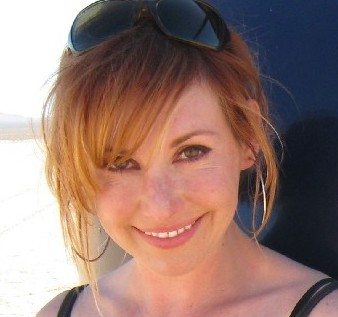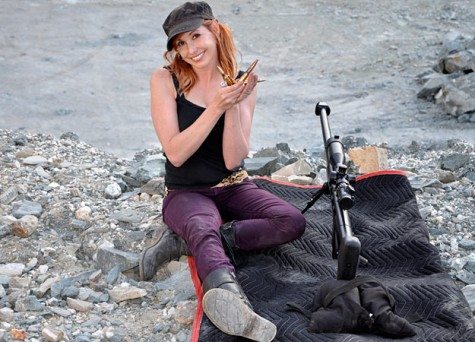 GeekMom is thrilled to bring our readers another column by Kari Byron, the female face on the hit Discovery Channel show MythBusters and host of the Science Channel’s new Head Rush. Kari sends us regular updates on life as a MythBuster Mom.
GeekMom is thrilled to bring our readers another column by Kari Byron, the female face on the hit Discovery Channel show MythBusters and host of the Science Channel’s new Head Rush. Kari sends us regular updates on life as a MythBuster Mom.
Science is hot right now. Everywhere I travel parents are in a panic to get their kids interested in science. I guess one day, America woke up and realized our pipeline of home-grown engineers, scientists, and inventors was drying up.
Let’s face it: subjects like science and math have an unfortunate reputation for being boring and dry and, dare I say, even “nerdy.” Honestly, that is how I felt when I was 12. Science was so often taught as a list of facts to memorize: “List the components of a cell,” “What does H2O stand for?” “Who is the father of the theory of relativity?” Snore. I didn’t understand why science couldn’t be more like art class. So I can understand where kids are coming from today.
Another huge roadblock for students is the lack of role models in the fields of science, technology, engineering and math (what the President calls the STEM initiative) in our media-driven world of glamour, fame, and money. Close your eyes and picture a scientist. Do you see an awkward nerdy man with bad posture, glasses and a lab coat? Who wants to be him when you are inundated with exciting visions of gorgeous movie stars and rich athletes?
Solutions aren’t easy. Parents ask me, “How do I get my kid into science?”
The good news is that if you are asking that question it probably means you are half way there. Being involved is an amazing start. A parent is the most important role model, regardless of what your eye-rolling tween says.
I like to teach science to kids like I teach art. Get their hands dirty. Engage their natural curiosity. Drop Mentos into a bottle of Diet Coke and let it explode all over the backyard. Snap! That’s chemistry. Show them science isn’t just answers on an exam, but the world all around you. Take a nature walk with a camera. Bring home pictures of animals and find out what they eat, when they sleep. Snap! That’s biology. I also like to call it hiding the broccoli in the cheese sauce. Making science more hands-on creates a base of scientific literacy as well as quality time bonding. Your kids will be learning in spite of themselves. That look of wonder and discovery you see in their faces will become addictive — for both of you.
That’s how MythBusters became a juggernaut of science engagement for kids. We weren’t trying to teach science, we were just having fun while using science as a tool. They see us having fun and join us on the journey.
There you have it, sage advice from a totally unqualified former art major who now loves science and uses it every day.




I thought it was going To be some boring old post, but it okay compensated as my time. I went post a link how to this url by my site. I am sure my visitors will think of that very useful
I thought it was going To be some boring old post, but it okay compensated as my time. I went post a link how to this url by my site. I am sure my visitors will think of that very useful
You haved implored yourself through this post and it’s delicious to read. Decent work.
You haved implored yourself through this post and it’s delicious to read. Decent work.
Lol my mom just ordered replicas of Kate Middleton’s ring. XDDDD
Lol my mom just ordered replicas of Kate Middleton’s ring. XDDDD
We think all the attention around The governators kid lately is insane. Just leave the kid alone..maybe The Governator needs to answer questions, but leave the poor kid alone.
We think all the attention around The governators kid lately is insane. Just leave the kid alone..maybe The Governator needs to answer questions, but leave the poor kid alone.
Getting more kids – especially more women – interested in STEM (science, technology, engineering and math) fields is so important for our country. After all, women are 52% of the population – we need more children – and more women – pursuing STEM degree. I’ve had the privilege of interviewing not only Kari Byron for my education blog (OneDublin.org) but also the president of Harvey Mudd (Dr. Maria Klawe), Social Roboticist Heather Knight and Google Product Manager Johanna Wright. For parents interested in how to get their daughters interested in STEM fields, the Dr. Klawe interview is a good place to start: http://onedublin.org/2011/09/10/harvey-mudd-college-president-maria-klawe-on-women-in-science-math-and-engineering/. And to Ms. Byron – keep doing what you are doing – it’s making a difference!
Getting more kids – especially more women – interested in STEM (science, technology, engineering and math) fields is so important for our country. After all, women are 52% of the population – we need more children – and more women – pursuing STEM degree. I’ve had the privilege of interviewing not only Kari Byron for my education blog (OneDublin.org) but also the president of Harvey Mudd (Dr. Maria Klawe), Social Roboticist Heather Knight and Google Product Manager Johanna Wright. For parents interested in how to get their daughters interested in STEM fields, the Dr. Klawe interview is a good place to start: http://onedublin.org/2011/09/10/harvey-mudd-college-president-maria-klawe-on-women-in-science-math-and-engineering/. And to Ms. Byron – keep doing what you are doing – it’s making a difference!
WOW! You rock! I was a girl in the 50’s/60’s, and our role models were Barbie and June Cleaver. Bleah. So not me. I had two great things: unstructured play time in the natural world (read Last Child in the Woods: Richard Louv) and books. I read about Madame Curie. About the discovery of the coelocanth (I still can’t spell it). About the adventures of Jaques Cousteau. On Star Trek, I saw that science was cool (now I’m using automatic sliding doors, touch screen computers and….hey, why won’t my communicator beam me up???).
I am primarily an artist/storyteller who loves educating people, especially kids. We need science teachers, bio teachers, to make the subjects exciting, to engage curiosity. We need local parks and .orgs involving kids in programs which excite them about their world (some of the best educational programs I’ve seen have been in parks and non-profts). We need artists, writers, movie makers to create stories which make kids go out and explore. We need TV to move the lens from the glamour and fake draaaaamaaaaah to science, history and the natural world…it’s doing so, slowly, but I think we’re making progress.
WOW! You rock! I was a girl in the 50’s/60’s, and our role models were Barbie and June Cleaver. Bleah. So not me. I had two great things: unstructured play time in the natural world (read Last Child in the Woods: Richard Louv) and books. I read about Madame Curie. About the discovery of the coelocanth (I still can’t spell it). About the adventures of Jaques Cousteau. On Star Trek, I saw that science was cool (now I’m using automatic sliding doors, touch screen computers and….hey, why won’t my communicator beam me up???).
I am primarily an artist/storyteller who loves educating people, especially kids. We need science teachers, bio teachers, to make the subjects exciting, to engage curiosity. We need local parks and .orgs involving kids in programs which excite them about their world (some of the best educational programs I’ve seen have been in parks and non-profts). We need artists, writers, movie makers to create stories which make kids go out and explore. We need TV to move the lens from the glamour and fake draaaaamaaaaah to science, history and the natural world…it’s doing so, slowly, but I think we’re making progress.